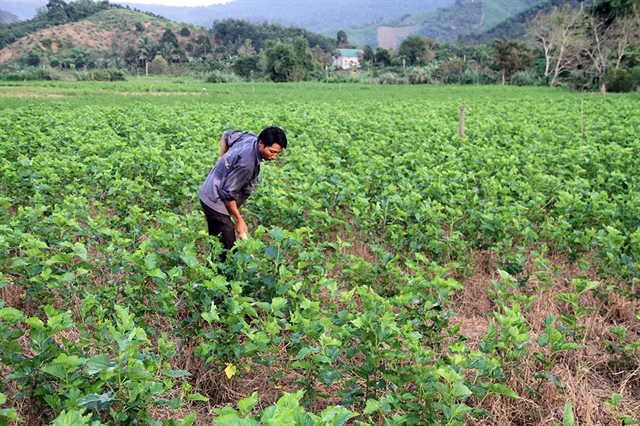 Society
Society

The Lâm Đồng Province People’s Committee has approved a five-year plan for the sericulture industry which targets having 9,500 – 10,000ha of mulberry farms by 2023.

|
| Planting mulberry in Lâm Đồng Province’s Đạ Tẻh District. – Photo baolamdong.vn |
LÂM ĐỒNG — The Lâm Đồng Province People’s Committee has approved a five-year plan for the sericulture industry which targets having 9,500-10,000ha of mulberry farms by 2023.
Of them 8,100-8,500ha will have new and hybrid mulberry varieties with high yields and 1,900-2,000ha will be farmed using advanced techniques.
The Tây Nguyên (Central Highlands) province will produce at least 30 per cent of its demand for silkworm eggs, 14,000-14,500 tonnes of silkworm cocoons a year and 1,800-1,900 tonnes of silk a year.
The plan envisages, to create value chains, establishing at least three linkages between districts: Đức Trọng District-Lâm Hà District-Đam Rông District, Di Linh District-Bảo Lâm District-Bảo Lộc City and Đạ Huoai District-Đạ Tẻh District-Cát Tiên District.
The province will take several measures to sustainably develop sericulture, including strengthening research and production of silkworm eggs and giving priority to switching to certified high-yield mulberry varieties like S7-CB, TBL-03, VA-201 and TBL-05.
It also plans to expand the area under mulberry in places that have silk producing plants and develop sericulture villages that also offer tourism services.
It will solicit investment in mulberry farms and silkworm breeding and support activities to promote the province’s silk in Việt Nam and abroad.
It will help farmers switch to mulberry from low-yield rice farming in places like Đam Rông, Đạ Huoai, Đạ Tẻh, and Cát Tiên districts and from perennial industrial trees in Đức Trọng, Lâm Hà, Di Linh, and Bảo Lâm districts and Bảo Lộc City.
Bảo Lộc, Lâm Hà and Di Linh are the province’s leading silk producers.
The province produced 8,904 tonnes of silkworm cocoons and 1,187 tonnes of silks last year.
It accounts for 67 per cent of the country’s total mulberry area.
More than 14,000 households are involved in growing mulberry and breeding silkworms.
The sericulture industry boomed in the 1990s but later declined because of failure to adopt advanced silk production techniques.
There has been a revival since 2010.
The industry now plays an important role in the province’s socio-economic development and agriculture, according to its People’s Committee. VNS




